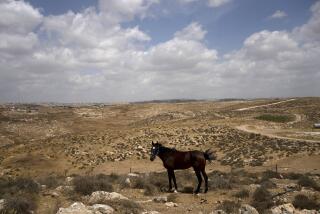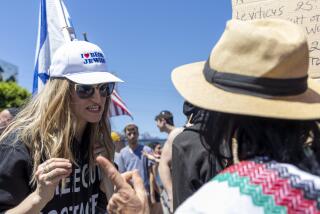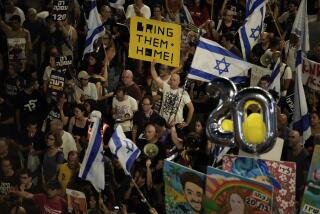A City Divided Is Peace Talks’ Toughest Knot
- Share via
JERUSALEM — In East Jerusalem, where streets are named for sultans and legendary Muslim warriors, Arab women in embroidered dresses jostled on the sidewalk Wednesday selling mint and cilantro. Old men in checkered kaffiyehs sat on plastic chairs, seeking shade and sipping sweet tea. Children walked home from classes where they study a Jordanian curriculum.
An Israeli police van passed, an agent inside barking orders through a megaphone to pedestrians and to minibus drivers double-parked near Damascus Gate.
The money changers, shwarma restaurants, jewelry stores and other businesses here along Salahadin Street are owned and run by Arabs. The symbols of authority--the post office, the nearby Justice Ministry fortified by barbed wire--are Israeli. Some residents of East Jerusalem pay their electricity bills to a Palestinian company. Two blocks away, residents of West Jerusalem pay an Israeli firm.
Jerusalem is a crowded, ghettoized, breathtaking city where Israelis and Palestinians survive side by side but in separate worlds. For 33 years, Israel has sought to unify the city under its rule, while Palestinians have clung to a fervent claim on East Jerusalem as the capital of a future state.
The city’s status may well be the deal-breaker in last-ditch summit talks this week between Israeli Prime Minister Ehud Barak and Palestinian Authority President Yasser Arafat.
With President Clinton as host, the summit continued Wednesday at Camp David, Md. The three leaders hope to reach agreement on the final, most contentious issues dividing the two sides, and in so doing end more than half a century of conflict.
Jerusalem is far from the only point of contention. The key issues and widely reported positions include:
* Land: Israel is prepared to cede up to 90% of the West Bank, most of it immediately and a portion over the next several years. Publicly, the Palestinians want it all, but compromise here is considered likely.
* Settlements: Israel wants to annex up to 10% of the West Bank and the Gaza Strip for about 150,000 Jewish settlers. An additional 40,000 settlers would have to submit to Palestinian authority or move. Israel might consider a land swap, giving a small amount of land it holds in exchange for the settlement blocks.
* Refugees: About 3 million Palestinian refugees live in the West Bank, the Gaza Strip and Arab countries. Palestinians want Israel to acknowledge responsibility for forcing them to flee, and to recognize a Palestinian right to return. Israel refuses both but suggests an international plan to compensate the refugees for their lost land.
But by most accounts, an agreement over Jerusalem--which has served as theater for many of humankind’s epic battles--will be the most difficult to come by.
Israel maintains that Jerusalem is its “eternal and indivisible” capital, the center of Judaism and Jewish history, and the anchor of the Jewish state. The Palestinians point to what many see as a de facto division between East and West Jerusalem to buttress their claim to the eastern sector of the city.
Israel captured the eastern side, including the Old City, from Jordan in the 1967 Middle East War and has spent the decades since expanding the city’s borders and building up Jewish neighborhoods.
“Jerusalem is the heart of the heart of the Jewish people,” Haim Ramon, Barak’s minister for Jerusalem affairs, said Wednesday.
Palestinian leaders have been as adamant as Barak in stating that there can be no compromise on Jerusalem--and no peace without Jerusalem.
“We are a people, we have a name, we want a capital,” Faisal Husseini, the senior Palestinian official in East Jerusalem, said Wednesday.
The most sensitive component of the debate is the Old City, the ancient, cramped enclave where some of the world’s most important religious shrines are located. The Western Wall, the last remnant of the biblical temples, is the holiest site in Judaism. Just above it is the Dome of the Rock and Al Aqsa mosque, third-holiest site for Muslims. And for most Christians, the Church of the Holy Sepulcher is the place of Jesus’ burial and resurrection.
Although Israel has sovereignty over the Old City, the holy sites are administered by religious trusts as part of a “status quo” agreement in force for decades.
North and east of the Old City is East Jerusalem, a rundown area where most of Jerusalem’s Arabs reside. According to official Israeli statistics, Jerusalem’s population of about 625,000 is now 69% Jewish.
With the exception of police officers and a few government workers, Jewish Israelis rarely venture into East Jerusalem. An invisible psychological divide separates east from west at the Route 1 highway that runs along what used to be the so-called Green Line.
Human rights groups and several former Israeli municipal officials say successive Israeli governments have practiced a policy of deliberately attempting to reduce the size of Jerusalem’s Arab population by restricting building permits and revoking residency documents when an Arab has lived outside the city for seven years.
Arab residents of East Jerusalem pay municipal taxes but complain that they are denied their fair share of city services. On the other hand, as residents of Jerusalem they have access to Israeli medical care. Most boycott local elections and are not permitted to vote in national elections because they are not Israeli citizens.
Ways to resolve the competing claims to Jerusalem have been debated for years, and in recent months a number of creative solutions have emerged. The key is evolving definitions of “sovereignty” and even “city.”
Some Israeli officials say they are willing to hand over several Arab neighborhoods in East Jerusalem, such as Beit Hanina and Shuafat, to limited Palestinian management. The Arab village of Abu Dis, just outside the Jerusalem city border, is already under partial Palestinian control and is the site of a new building rumored to be the future home of the Palestinian parliament.
Other Israeli officials, however, say that goes too far. Ehud Olmert, the right-wing Israeli mayor of Jerusalem, says allowing Palestinian authority into some of the neighborhoods would cut off and endanger newer Jewish areas. It would be “a prescription for endless confrontations,” he said.
Olmert was speaking Wednesday at a news conference for foreign reporters, where he trotted out a colorful map meant to show the perils of sharing Jerusalem. It was a blotchy patchwork of pink, yellow and brown representing Arab neighborhoods under various combinations of Israeli-Palestinian jurisdiction.
Lest there be any doubt that the battle for hearts and minds and international public opinion is in full swing, Olmert’s rivals were waiting outside the news conference to present an alternative view. Members of the Jerusalem City Council from the leftist Meretz party demanded compromise on the city’s future, saying the only peaceful and dignified solution is joint sovereignty of two nations.
“Jerusalem is in fact a divided city,” said Anat Hoffman, one of the council members. East Jerusalem, in particular, is a “time bomb” created by years of Israeli neglect, she said, where authorities have failed to collect garbage, pave streets and repair lights.
Olmert acknowledges that East Jerusalem suffers from neglect but says the Palestinian claim to any portion of the city is absurd.
An agreement at Camp David “must reflect the historical realities of Jerusalem, not the artificial realities that Arafat wants to create,” Olmert said. “The historical reality is that Jerusalem never was in any part of its history a capital for any Muslim nation, for any Arab nation. There is no Palestinian heritage, no Palestinian tradition, no Palestinian history in the city of Jerusalem.”
Palestinians scoff at that argument. “The solution is two capitals in one city,” said Husseini, the senior Palestinian official. “We already made the historic compromise. . . . We already gave up West Jerusalem.”
Husseini was presiding over a ceremony in support of Arafat at the Orient House in East Jerusalem. Orient House is a de facto foreign ministry for the Palestinian Authority, which is barred from operating in East Jerusalem. Told of Olmert’s contention that Jerusalem has never been an Arab or Muslim capital, Husseini pointed at the turn-of-the-century building, with a red, green and black Palestinian flag fluttering on the front lawn.
“This building was here, functioning, before anyone was even dreaming of an Israeli foreign minister,” he said. “So who was first?”
More to Read
Sign up for Essential California
The most important California stories and recommendations in your inbox every morning.
You may occasionally receive promotional content from the Los Angeles Times.











